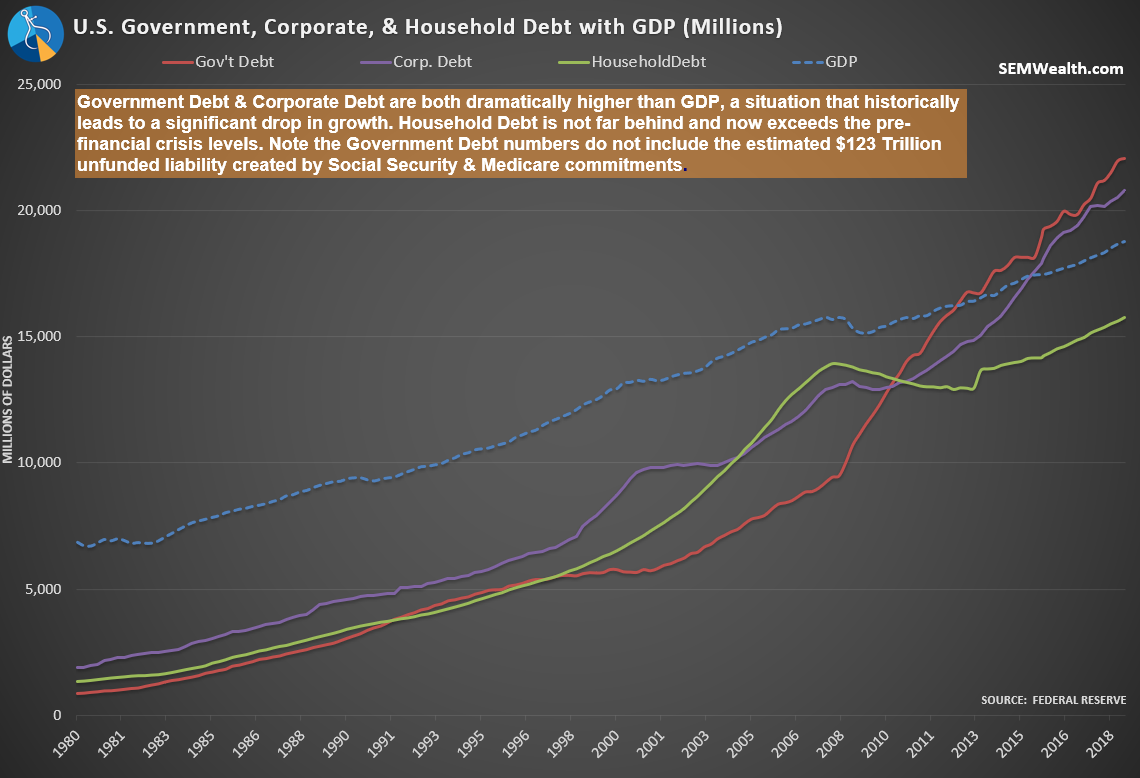Debt is future spending brought forward. Another way to think about it, debt will hurt future spending. As I was talking to several advisors and clients this week after the end of tax season I couldn’t help but think of our country’s debt problems. Few people want to acknowledge it as a problem, but simple math and logic tells us tax rates will never be lower in our lifetimes than they are right now.
Despite the complaint from individuals that their taxes didn’t go down (because they received their tax cuts each paycheck rather than in one large lump sum), tax rates were down significantly. Unfortunately, the tax cuts did not have the promised benefit of 4%+ GDP growth for years to come. Since the government is spending MORE money we are looking at even more debt. All signs are economic growth is slowing rapidly.
Not to be outdone, corporations have gone crazy adding to their debt loads. They used the easy money to buyback stock, pay bonuses, and increase dividends. Like the government, they did little to create sustainable growth with their debt and they too are facing a rapid decline in profit growth. Households have not gotten as crazy as the government and corporations, but they have more debt now than before the crisis. The difference this time is the fastest growth has been in student debt and car loans, both items that cannot easily be sold back to pay off the balance owed.

ILLUSTRATIVE PURPOSES ONLY — PLEASE SEE DISCLAIMER AT BOTTOM OF PAGE
This isn’t just a US problem. All around the world the “solution” from leaders to fight the global financial crisis was to create new currency to buy debt from the banks. This created an environment where those that shouldn’t be borrowing money not only were able to do so, but at rates that were too low to compensate lenders (bond investors) for the risk they were taking.
When the economy slows and all signs point to us being already in a global recession, with the US fighting to maintain 2% growth, it will become increasingly difficult for the borrowers on the fringes to make their debt payments. The growth they were supposed to be generating with the debt never materialized, yet now they have to find money to pay back what they borrowed. When the fringes start having problems fear will set in and even previously thought of stable borrowers will start to have problems borrowing money to stay afloat. A new crisis will have begun, caused by the “solution” used to fight the last crisis.
This weekend John Mauldin had a section of his weekly letter that I think everyone should be planning for:
During the worldwide recession, there will be few qualified borrowers but a great demand for liquidity as corporate debt goes from investment grade to junk seemingly en masse. Which will disqualify them from being bought by pensions, insurance companies, and many other purchasers normally looking for yield.
What assets will the Fed buy? Under current law, that’s pretty predictable: Treasury securities and a few other government-backed issues like certain mortgage bonds. That’s all the law allows. But laws can change and I think there is a real chance they will—regardless of which party holds the White House and Congress. In a crisis, people act in previously unthinkable ways. Think 2008–2009.
They will think the unthinkable in the next crisis and try everything, including the kitchen sink, but it will just increase government debt. This will just serve to slow economic growth even further long-term and put additional strain on zombie corporations.
I of course zeroed in on the investment grade bond and insurance company portions. Our readers know I’m gravely concerned about the Investment Grade Junk bonds that are hanging over our country that will likely cause severe issues with many annuity issuers. Despite the angry emails and phone calls I received after posting those two articles I will stand by my research and experience. It’s not a question of IF we have another crisis, but rather WHEN we have another one. We should expect our leaders to be too slow to respond followed by actions that will surprise all of us. The question then will be how will the citizens react if they attempt to bail out the same institutions that caused the last crisis and received bailouts last time around.
How it unfolds is anyone’s guess and one we do not have to make. We will continue to follow the data led by our single best early-warning trading system, our high yield bond trend following system. If this melt-up continues, great! We are participating nicely and are enjoying one of our best starts to the year in a very long time. If it comes crashing back down we’ll be ready for that too.




